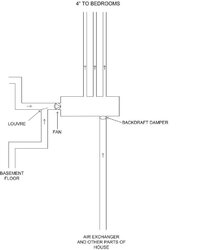Hello everyone, its nice to be here. I have some questions I would like to discuss with some experienced wood burners and this forum looks like the place to do it! First I'd like to give a little background on the house.
The house is based off this floorplan
http://www.houseplans.com/plan/2970...-southern-colonial-house-plans-3-garage-36817
with a some modifications. The square "house part" is actually sitting on a nine foot basement, the main floor has 9' ceilings, and the garage and breezway will sit on a slab when I get around to building that portion. The house has hot water heat(gas) on each floor, one thermostat per floor. Each room is supplied with 4" round ducting connected to an air exchanger. The Alderlea will sit by the breakfast area on the main floor. We just moved in and I will probably install the stove later this summer.
My question is about heat in the bedrooms. My goal here is that when the wood stove is in use, I would like the heat to be distributed enough that I will not need to run my upper floor heat loops.
So here's my plan.
I would like to add some 6" ductwork on seperate fan that will pull warm air from behind the stove and exhaust it into the bedrooms. This will serve the dual purpose of blowing cool air off the basement floor in the summer time with the addition of louvre. The ducting from the 3 bedrooms will tie into a seperate header witch will tie into the air exchanger and the fan. I attached a quick sketch.
The air exchanger and the circulation fan will be electrically interlocked so only one can run at a time. The air exchanger I have does not have a circulation feature, but the programmable controller does, so I will install the control relays off of that so they will play nice together.
So after all that, my question is....
Is this going to work or am I wasting my time?
At this point the ducts are just stubbed into the basement and the air exchanger is sitting at the suppliers waiting for me to pick it up, its not a lot of extra work to do the ductwork this way instead of a traditional system but is added time and money.
Does anyone have a similiar set up and how does it work for you? Thanks
edit: Sorry if I'm in the wrong forum, not sure if it should be here or maybe the DIY
The house is based off this floorplan
http://www.houseplans.com/plan/2970...-southern-colonial-house-plans-3-garage-36817
with a some modifications. The square "house part" is actually sitting on a nine foot basement, the main floor has 9' ceilings, and the garage and breezway will sit on a slab when I get around to building that portion. The house has hot water heat(gas) on each floor, one thermostat per floor. Each room is supplied with 4" round ducting connected to an air exchanger. The Alderlea will sit by the breakfast area on the main floor. We just moved in and I will probably install the stove later this summer.
My question is about heat in the bedrooms. My goal here is that when the wood stove is in use, I would like the heat to be distributed enough that I will not need to run my upper floor heat loops.
So here's my plan.
I would like to add some 6" ductwork on seperate fan that will pull warm air from behind the stove and exhaust it into the bedrooms. This will serve the dual purpose of blowing cool air off the basement floor in the summer time with the addition of louvre. The ducting from the 3 bedrooms will tie into a seperate header witch will tie into the air exchanger and the fan. I attached a quick sketch.
The air exchanger and the circulation fan will be electrically interlocked so only one can run at a time. The air exchanger I have does not have a circulation feature, but the programmable controller does, so I will install the control relays off of that so they will play nice together.
So after all that, my question is....
Is this going to work or am I wasting my time?
At this point the ducts are just stubbed into the basement and the air exchanger is sitting at the suppliers waiting for me to pick it up, its not a lot of extra work to do the ductwork this way instead of a traditional system but is added time and money.
Does anyone have a similiar set up and how does it work for you? Thanks
edit: Sorry if I'm in the wrong forum, not sure if it should be here or maybe the DIY


